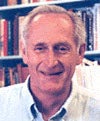
Kretsinger, Robert H.
Education
- PhD, , Massachusetts Institute of Technology
Contact Information
PO Box 400328
Gilmer Hall Room, 63
Telephone: 434-982-5764
Email: rhk5i@virginia.edu
Research Disciplines
Biochemistry, Bioinformatics and Genomics, Computational Biology, Molecular Biology
Research Interests
Structure and Mechanism of Enzymes; Evolution of Ca-Modulated Proteins
Research Description
In 1974 I presented a general hypothesis that has guided much of our subsequent research:
1.??? Resting cells maintain the concentration of free Ca2+ ions in the cytosol between 10 8 and 10 7 M.
2.??? The sole function of calcium in the cytosol is to transmit information.
3.??? The target of calcium, functioning as a second messenger, is a protein(s) in the cytosol.
4.??? Calcium modulated proteins are homologs, containing EF-hands.
5.??? Cells extrude calcium so they can use phosphate as their energy currency; Ca3(PO4)2 is insoluble.
We have completed an extensive analysis of the evolution of >1000 EF-hand homolog proteins and identified 78 distinct subfamilies.? Some subfamilies, such as calmodulin, troponin C, essential light chains, and regulatory light chains of myosin, are congruent; all evolved from a single protein that contained four EF-hand domains.? Others, like calpain, evolved from a single EF-hand domain by recent gene duplications and fusions.? Most other subfamilies have complex evolutionary histories involving multiple gene translocations and splicings.? We are exploring models that characterize changes in conformation of pairs of EF-hand associated with calcium binding and with interactions with effectors.? These studies laid the foundation for writing Calcium Binding Proteins -E. A. Permyakov and R.H. Kretsinger (Wiley) 2010.
In collaboration with Ron Bauerle in our Biology Department we have determined the crystal structures of 3-deoxy-D-arabino-heptulosonate-7-phosphate synthase from E. coli. in complex with phosphoenol pyruvate and in complex with the feedback inhibitor, phenylalanine.? DAHPS(Phe) condenses arabinose-4-phosphate and PEP to form DAHP, the precursor of all aromatic compounds in bacteria and plants.? The sites of PEP, the essential divalent cation, and E4P are located near the C-end of an eight strand -barrel.? The plane of PEP is twisted 30o about the C, C bond, an inferred essential step in catalysis. The crystal structure of DAHPS*Mn*PEP*Phe shows the changes in structure associated with feedback regulation.? The inhibited enzyme cannot bind E4P and the PEP is flipped so that its carboxylate and phosphate groups are interchanged.
